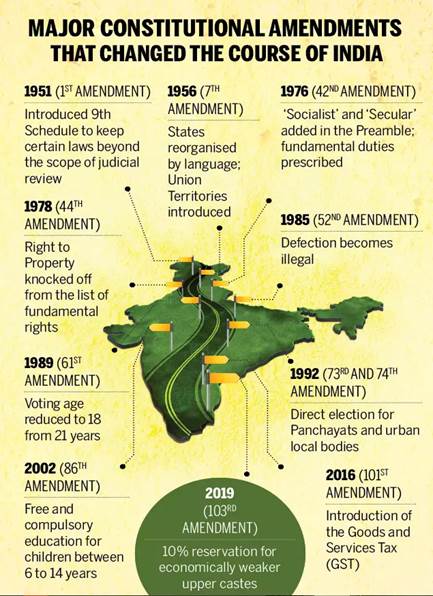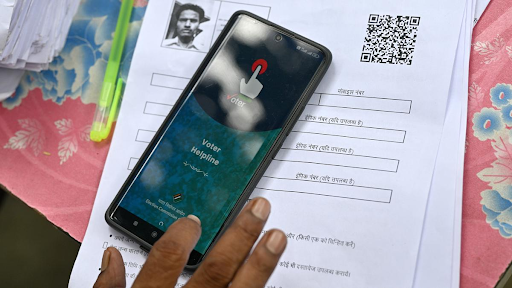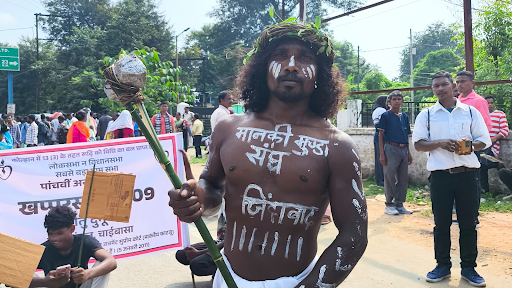Description

Copyright infringement not intended
In News
- The Supreme Court of India accepted a petition that challenged the restrictions on the fundamental right to freedom of speech and expression that was introduced by the first constitutional amendment act.
- The petitioner argued that the amendment damages the basic structure of the Indian constitution.
About 1st Constitutional Amendment Act
- In 1951, Then Prime Minister Jawaharlal Nehru introduced the First Amendment Bill aimed at;
- Exempting land reforms measures taken by the government from judicial scrutiny.
- It also expanded the range of restrictions on the right to free speech.
- Indian Constitution under Article 19(1) (a) guarantees the fundamental right to freedom of speech and expression. But this freedom is not absolute.
- It is followed by Article 19(2), which lists “reasonable restrictions” on the right including;
- Interest in the sovereignty and integrity of India.
- Security of the State.
- Friendly relations with foreign States.
- Public order
- Decency or morality
- Contempt of court, defamation
- The first amendment introduced the term “reasonable restrictions” that Article 19(2) imposed. The insertion of the term “reasonable”, keeps the door open for the courts to step in and examine the legitimacy of the restrictions imposed by Parliament.
- In 1949, in Romesh Thappar v State of Madras case; the petitioner challenged a provision of the Madras Maintenance of Public Order Act, 1949 as unconstitutional. This provision authorised the government to impose restrictions for the wider purpose of securing “public safety” or the “maintenance of public order”.
- The Supreme Court defined the terms “public safety” and “public order”.
- The court struck down the provision as unconstitutional.
Constitutional Amendment
- The Indian Constitution is neither flexible nor rigid but a synthesis of both.
- Article 368 in Part XX of the Constitution deals with the powers of the Parliament to amend the Constitution and its procedure. It states that;
- The Parliament may add or repeal any provision of the Constitution according to the procedure laid down.
- However, the Parliament cannot amend those provisions which form the ‘basic structure’ of the Constitution. This was ruled by the Supreme Court in the Kesavananda Bharati case.
Procedure for the amendment
- The constitutional amendment bill can be initiated only in the Parliament and not in the state legislatures.
- The bill can be introduced either by a minister or by a private member and does not require prior permission of the president.
- The bill must be passed in each House by a special majority; a majority of the total membership of the House and a majority of two-thirds of the members of the House present and voting.
- Each House must pass the bill separately. There is no provision for holding a joint sitting of the two Houses in case of a constitutional amendment bill.
- If the bill seeks to amend the federal provisions of the Constitution, it must also be ratified by the legislatures of half of the states by a simple majority; a majority of the members of the House present and voting.
- After duly passed by both the Houses of Parliament and ratified by the state legislatures, where necessary, the bill is presented to the president for assent.
- The president must give his assent to the bill. He can neither withhold his assent to the bill nor return the bill for reconsideration.
- After the president’s assent, the bill becomes an Act (constitutional amendment act).
List of Important Constitutional Amendments
1st Amendment Act, 1951
- The state was empowered to make special provisions for the advancement of social and backward classes.
- Secure The Constitutional Validity of zamindari abolition laws.
- Schedule 9 was added to protect laws that are Contrary to Fundamental rights.
- Introduced 3 grounds of restrictions on Article 19 (1) [Freedom of speech and expression] were added:
- Public order
- Friendly relations with foreign states
- Incitement to an offence
7th Amendment Act, 1956
- The provision of having a common High Court for two or more states was introduced.
- Abolition of Class A, B, C, and D States.
- Reorganization of states on linguistic lines.
- Introduction of Union Territories
- 14 States and 6 Union Territories were formed
10th Amendment Act, 1961
- Dadra, Nagar, and Haveli were incorporated into the Union of Indians as a Union Territory.
12th Amendment Act, 1962
- Goa, Daman and Diu were incorporated into the Indian Union as a Union Territory.
13th Amendment Act, 1962
- Nagaland was formed with special status under Article 371A.
14th Amendment Act, 1962
- Pondicherry was incorporated into the Indian Union.
- Union Territories of Himachal Pradesh, Manipur, Tripura, Goa, Daman and Diu and Puducherry were provided by the legislature and council of ministers.
19th Amendment Act, 1966
- The system of Election Tribunals was abolished and High Courts were given the power to hear the election petitions.
21st Amendment Act, 1967
- The Sindhi language was a language in the 8th Schedule of the Indian Constitution.
24th Amendment Act, 1971
- The President’s assent to The Constitutional Amendment Bill was made compulsory.
25th Amendment Act, 1971
- The Fundamental Right to Property was curtailed.
26th Amendment Act, 1971
- Privy Purse and privileges of former rulers of princely states were abolished.
31st Amendment Act, 1972
- Lok Sabha seats were increased from 525 to 545.
35th Amendment Act, 1974
- The status of Sikkim as a protectorate state was terminated and Sikkim was given the status of ‘Associate State’ of India.
36th Amendment Act, 1975
- Sikkim was made a full-fledged state of India.
40th Amendment Act, 1976
- Parliament was empowered to specify from time to time the limits of the territorial waters, the continental shelf, the exclusive economic zone (EEZ) and the maritime zones of India.
42nd Amendment Act, 1976
- The 42nd Amendment Act is the most comprehensive amendment of the Indian Constitution, therefore called the ‘mini-the constitution.
- Preambles included “SECULAR, SOCIALIST” and “unity of the Nation” and were substituted with “unity and integrity of the Nation.”
- Added Chapter IV-A which consists of only one Article 51-A which deals with a Code of Ten Fundamental Duties for citizens.
- Equal justice and free legal aid to economically backward classes.
- Participation of workers in the management of industries.
- Protection and improvement of the environment and safeguarding of forests and wildlife.
- The Supreme Court will have no jurisdiction to decide the constitutional validity of a law.
- President to act under the advice of the Council of Ministers.
- A person is disqualified if he holds any office of profit under the Government.
- Government to deploy armed forces in any State.
- Supremacy of Parliament; No constitutional amendment will be questioned in any Court on any ground.
- Added “Population Control and Family Planning” to Concurrent List.
- Laws made for the implementation of Directive Principles Cannot be declared invalid by Courts on grounds of violation of Fundamental Rights.
- Added ‘Tribunals’: 323 A for dealing with administrative tribunals and Article 323 B dealing with tribunals for other matters.
- 5 Subjects were transferred from State to Concurrent List: Education, Forests, Weights & Measures, Protection of Wild Animals and Birds, and Administration of Justice.
44th Amendment Act, 1978
- The constitutional Protection to Publication in a newspaper of the Proceedings of Parliament.
- Empowered the President to Send back advice from the Council of Ministers for reconsideration.
- Restoration of Some Powers of the Supreme Court.
- Fundamental Rights Guaranteed by Articles 20 and 21 cannot be suspended during a National emergency.
- Replaced the word “internal disturbance” with “armed rebellion”.
- President to declare a National Emergency only on the written recommendation of the Cabinet.
- The duration of a National emergency should not be extended more than 6 months at a time.
- The right to Property was taken out of Fundamental Rights and added as a legal right.
- Judicial review of the election of President, Governors and LS Speaker.
- Added One DPSP: State to minimize inequalities of income, Status, Facilities and opportunities.
52nd Amendment Act, 1985
- The 10th Schedule was added providing for anti-defection laws.
61st Amendment Act, 1989
- The voting age was decreased from 21 to 18 for both Lok Sabha and Legislative Assemblies elections.
65th Amendment Act, 1990
- Multi-member National Commission for SC/ST was established and the office of a special officer for SCs and STs was removed.
69th Amendment Act, 1991
- Union Territory of Delhi was given the special status of ‘National Capital Territory of Delhi.’ A 70-member legislative assembly and a 7-member council of ministers have been established in Delhi.
71st Amendment Act, 1992
- Konkani, Manipuri and Nepali languages were included in the Eighth Schedule of the constitution.
- The total number of official languages increased to 18.
73rd Amendment Act, 1992
- Panchayati Raj institutions were given constitutional status.
- A new Part-IX and 11th Schedule were added to the Indian Constitution to recognize Panchayati Raj Institutions and provisions related to them.
74th Amendment Act, 1992
- Urban local bodies were granted constitutional status.
- A new Part IX-A and 12th Schedule were added to the Indian Constitution.
86th Amendment Act, 2002
- Elementary Education was made a fundamental right – Free and compulsory education for children between 6 and 14 years.
- A new Fundamental Duty under Article 51 A was added – “It shall be the duty of every citizen of India who is a parent or guardian to provide opportunities for education to his child or ward between the age of 6 and 14 years”.
88th Amendment Act, 2003
- Provision of Service Tax was made under Article 268-A – Service tax levied by Union and collected and appropriated by the Union and the States.

91st Amendment, 2004
- Restrict the size of the council of ministers to 15% of legislative members & strengthen Anti Defection laws.
92nd Amendment Act, 2004
- Bodo, Dogri (Dongri), Maithili and Santhali were added to the Eighth schedule.
- Total official languages were increased from 18 to 22.
96th Amendment Act, 2011
- Substituted "Odia" in the place of "Oriya".
97th Amendment Act, 2011
- Co-operative Societies were granted constitutional status.
- The right to form cooperative societies was a fundamental right (Article 19).
- A new Directive Principle of State Policy (Article 43-B) to promote cooperative societies.
- A new part IX-B was added to the constitution for cooperative societies.
100th Amendment Act, 2015
- To pursue the land boundary agreement of 1974 between India and Bangladesh, the exchange of some enclave territories with Bangladesh mentioned Provisions relating to the territories of four states (Assam, West Bengal, Meghalaya) in the first schedule of the Indian Constitution, amended.
101st Amendment Act, 2016
- Goods and Service Tax (GST) was introduced.
102nd Amendment Act, 2018
- The constitutional status was granted to the National Commission for Backward Classes (NCBC).
103rd Amendment Act, 2019
- A maximum of 10% Reservation for Economically Weaker Sections of citizens of classes other than the classes mentioned in clauses (4) and (5) of Article 15, i.e. Classes other than socially and educationally backward classes of citizens or the Scheduled Castes and the Scheduled Tribes.
104th Amendment Act, 2020
- Extended the reservation of seats for SCs and STs in the Lok Sabha and state assemblies.
- Removed the reserved seats for the Anglo-Indian community in the Lok Sabha and state assemblies.
105th Amendment Act, 2021
- To restore states' power to make their own OBC lists.
https://indianexpress.com/article/explained/first-amendment-to-constitution-challenged-supreme-court-8252509/
https://t.me/+hJqMV1O0se03Njk9













